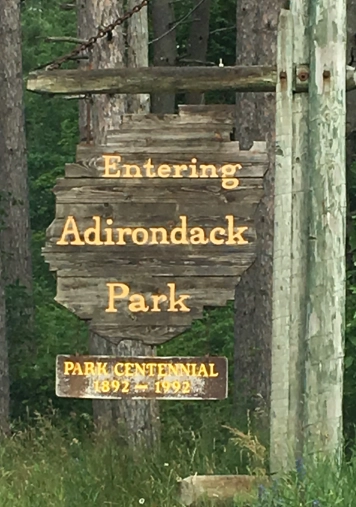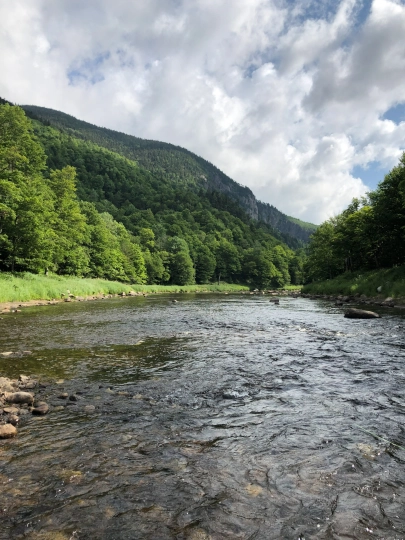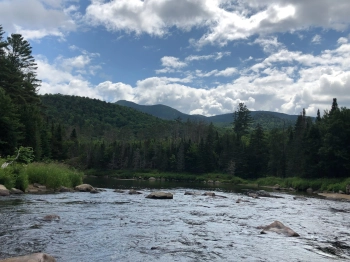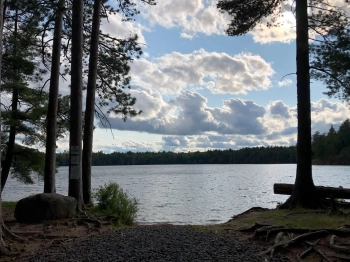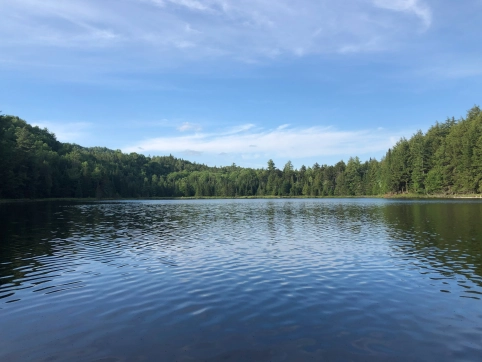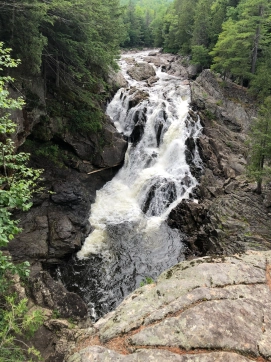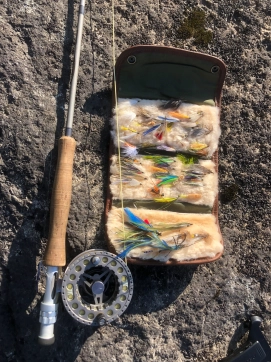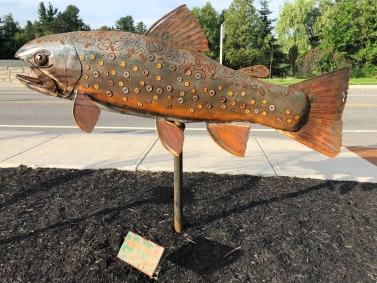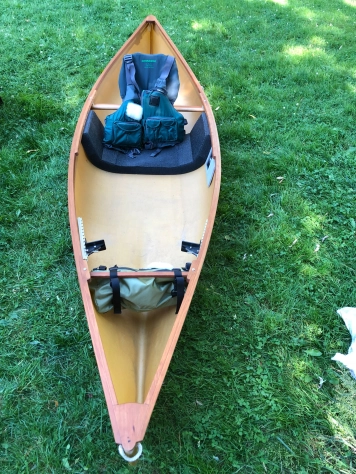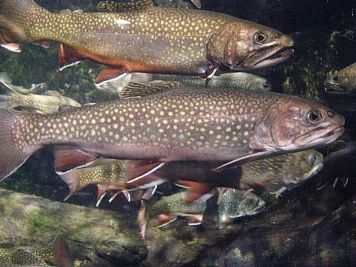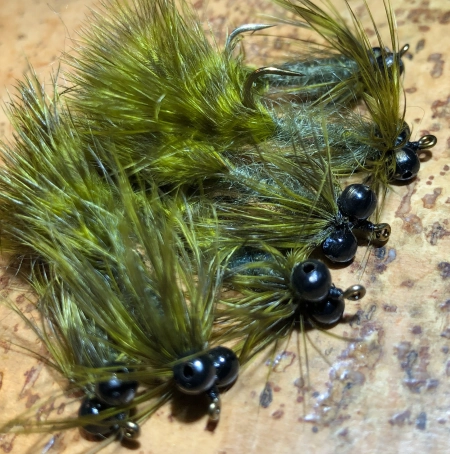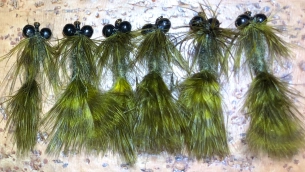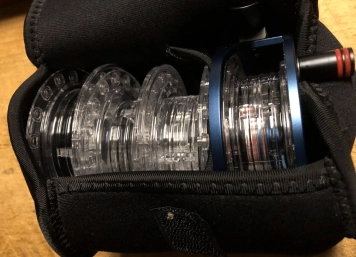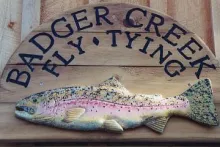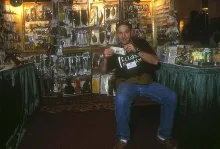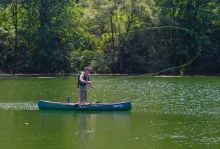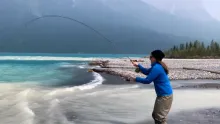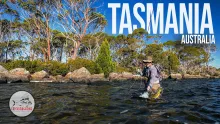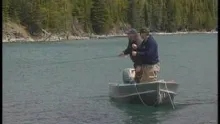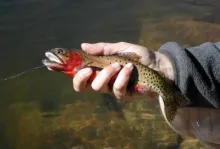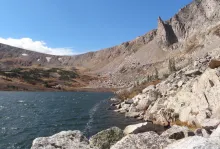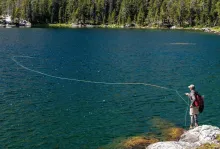Mountains, rivers, lakes, brooks and ponds. Loads of wildlife. A total of 6 million acres designated as "Forever Wild" ready to explore and fish.
I've been fly fishing in the Adirondacks for around 12-14 years now. I have a good many stories about my trips, but I'll share just a bit of my latest adventures on pond fishing. I try to make a trip at least once a year. A few times I've gone with my wife, mostly I go by myself and camp. I usually tent camp at the Wilmington Notch State Park. My tent camping isn't really "roughing it" since I pack my truck and drive into the site. One reason I like to camp is because it forces me to not watch TV and lets me unplug from things a bit. I have a cabin style tent that I can stand in, a cot with lots of comfy foam pads, a small table, a portable grill, stove and a propane light. I have a big cooler loaded with deli meats, cheeses, drinks, snacks and such. I bring food and drinks because I am often I am fishing in remote spots that don't offer any sort of amenities.
The Wilmington Notch Campgrounds is near Whiteface Mountain which was home to the alpine ski events in the 1980 Olympics. The camps sites aren't much and the park is a little basic (and so is the price - $18/ night or about 16 euros) but the park is right in the heart of the high peaks region and is on the West Branch of the Ausable River. If you don't have a tent, the KOA campground down the road offers lean to-s, and has a family canvas tent you can rent for several days.
From my camp site I can hike and fish in park's back yard which is a gorge that I love to fish for trout in. I've gotten a trout slam in the gorge before, catching a rainbow, brown and brook trout all on the same fly, in the same place and same day. From the camp site I can go further down the river, go to ponds, head to some of the area towns and also do some hiking, boating and biking. If you need supplies there are nearby fly shops, bars, restaurants and a small gas station-grocery store that makes great hot breakfast and deli sandwiches. Often I go out to dinner as there are several places to eat. A bonus is good cell coverage since the ski resort on top of the mountain has a tower. Most cell coverage in the park is limited to towns.
The Adirondacks are very close to me. Just 250 miles (or 400 kilometers). For international folks it's 4 1/2 hrs to New York City, 45 minutes to Montreal, Canada and 5 hours to Boston, MA. I suspect that few international folks will be surprised that a wilderness park is so close to these metro areas but it is. This is much closer than say Montana or western areas like Yellowstone National Park. The fishing is very much Northeastern and the woods, mountains and all are unique in their own respect. This area has been a tourist region and has attracted folks from near and far for many years. There are several Great Camps that had very wealthy families staying for the entire summer. Many of these are big mansions located in the woods, far from towns. Presidents, movie stars, musical talent, artists, captains of industry and athletes have all vacationed here. I believe Albert Einstein, Calvin Coolidge and Teddy Roosevelt all spent summers here. Most traveled by train and the lodges sent a wagon into town to pick up the sports.
It's strange that something this close to me seems like an African safari but it does. There's mountains, rivers, lakes, brooks and ponds. Loads of wildlife. A total of 6 million acres is designated as "Forever Wild” by the New York State Constitution. The park itself is about 20-25% of the State of New York. The Adirondacks are larger than Yellowstone, Teton, Smokey National Park and Yosemite combined. The Adirondacks is a mix of private and public ownership and is restricted in development, construction and also use. This is strictly a state park designation and is the largest park in the lower 48 states. The towns are cool and there aren't box stores (like Walmart), malls, and drive ins (like McDonald's). There are lots of local Mom and Pop stores and family run places. Places with character and personality. Small towns and interesting places to visit. Lots of local charm.
Part of my fishing up north has been chasing brook trout in ponds. Brook trout are native fish to this region. They thrive in clean, cold water and are found in rivers, streams, small creeks and ponds. Brook trout ponds are one of the most closely guarded secrets, and it is this weird mix of out of the way places and spectacular scenery that makes this so interesting. People won't part with info easily and nobody wants to give out info freely. So it takes research and some physical attempts at this. You also can't give up easily. Add to this that I like to go in the summer (not the best time) and I fly fish. Put together, this is VERY difficult. Some of the hardest fishing I've ever done. Also I should mention I don't use power boats or electronics.
First off I don't believe that brook trout are particularly hard to catch. Finding brook trout is. These fish are small, colorful and very aggressive that love colorful flies with a personality. They are pretty much the bluegills of the trout world. Not exceedingly the smartest fish. Brook trout are symbolic of a clean, pure places as they don't tolerate any sort of issues with pollution, warm water temps or dirty water. Finding them means the water is clean, pure, cold and the environment is very good. I should mention the places I've visited are often spectacular in terms of scenery and also in terms of being secluded. Many ponds look like a picture post card and are a delight just for the beauty and the peacefulness. The majority of the time I have seen almost no one fishing and only a few odd and end paddlers or hikers.
The Adirondacks has had many issues with acid rain in the past and many ponds were nearly killed off in the 60-70's. New York has attempted to reclaim some of the waters by using chemicals like lime to reduce the acid and also restocking ponds with hatchery bred native stock captured from the area. Some ponds are so remote the state stocks them via helicopter as it is impossible to get stocking trucks into some of the ponds.
To get info I've visited with folks in the fly shops, guides, NY DEC program managers, friends and also a neighbor that researches these ponds through a local University (Cornell). Over time I've gotten some great leads and ideas. Also I've gotten a pretty good idea what sorts of flies to use. On my most recent trip a local Trout Unlimited member provided me with some new ideas of where to try.
One tip I can share is to locate paddling maps of the area. You can locate how to get to ponds with a paddling map. Since much of the area has little or no cell coverage, and GPS largely doesn't work it means no Google Maps. If you depend on that you'll get lost or never find your way. Paper maps are available from St. Regis Canoe Outfitters, Saranac, NY or the Mountaineer in Keene, NY. You can research ponds on the NYDEC web site (link listed below). This is a state fisheries agency. They'll outline what ponds are stocked and what ponds hold fish and what kinds. Some ponds are easy beside the road affairs while others require lots of research. Some ponds are more remote and require considerable effort to get to them.
Last summer I bought a light weight solo canoe called a Hornbeck. It's a lightweight canoe that weighs 15 lbs (about 7.5 kg) and is made of Kevlar. I bought the boat specifically to fish remote areas as the boat is designed and built locally to explore remote Adirondack ponds. With the rains last year, I hadn't really had much of a chance to get out much and see many areas with my new boat. Armed with my new boat and some new places to try, I was anxious to go fishing.
This year I did add some specialty equipment. With all of the clean water, the Adirondacks have a very large amount of black flies and mosquitoes. Black flies in particular are evil, tiny gnats that attack in droves. They'll swarm and follow you. Last summer in Maine, I had around 60-70 bites on my arms from just one evening of fishing. One of the best defensive things is clothes as I hate chemical sprays. I mixed sun tan oils and natural bug spray. I added a sun scarf, sun gloves, my breathable rain jacket, water sandals, neoprene socks and quick dry shorts. This allowed me to boat, hike and launch my boat in the water. One small issue with Hornbecks is they are close to the water and difficult to climb in and out. This necessitates the use of quick dry shorts and sandals. Wading boots are quite clunky and heavy.
I began exploring some of the suggested ponds. I am not going to mention the specific ones I visited, but I will tell you I was in the St. Regis area around Saranac Lake, NY. St. Regis is a famous back country canoe area near Paul Smith's College. Paul Smith's was a famous resort that at one time had hundreds of summer guests. PT Barnum of the famous circus was a regular guest. The lodge later burned down but was eventually donated and a college is in the former town. Paul Smith's is a base area for some remote trips.
There are many ponds you can visit in the St. Regis region and several trips you can take. Some are quite easy and some require you to carry a boat as a portage. In some of these trips you boat across one pond, get out and carry the boat to the next. One of the most famous trips is called "7 Carries” in which you carry the boat 7 times to paddle on 7 different ponds. My trips weren't going to be quite so involved. I had two short carries to visit a pond near a larger one.
I first boated two ponds and fished them quite extensively. I tried a number of techniques, flies and methods of fishing. In one case, I was rained out. I was in the pond fishing, the wind came up and I was caught in a downpour as I headed back and reloaded my boat. On another outing I had a hard time finding the landing and launch. It required some effort as I had to drive around a very small logging type trail to get to the boat landing.
My final trip was an area that had several connecting ponds. I had to boat across one and then locate the portage trail and haul the boat into the final pond. I began by fishing and boating. I cast to the shore and found some rising fish. In a side area I found fish feeding on damsel flies. I looked through my flies and found an old bead chain leech-damsel-dragon nymph pattern. I began casting and I'd cast to a riser and nothing. Pretty soon one would rise 15-20 feet away and I'd boat over and cast to that one. I did this game about 3-4 times alternating between 4-5 fish that were rising. I swapped flies and tried casting in front to the side and then between where the fish were. As soon as I was in one place they'd rise in another. A little bit flustered, I continued on since I had a lot of water to cover. I figured I'd catch that one on the way back.
I made my way around the pond and cut under a very low catwalk bridge. I thought I saw a trail sign only to discover it was a yellow NY DEC sign, marking the water as a brook trout special regulation water prohibiting the use of bait. I paddled around the pond several times and didn't find any trails leading on to the other pond. I got a bit anxious so I stopped got out and thought I'd try to see if I could pick up the map on my cell phone.
I found I was in the wrong spot. So I paddled over to the other side of the pond. I finally found the portage sign so I got out. I hiked back to locate the pond and see how far a carry this was. It wasn't too far so I decided to do two trips one with the gear and another with the boat. I packed up and started carrying the gear and I was immediately attacked by armies of mosquitoes. I was mostly covered but they found what open flesh I had and started their run. I covered up as much as I could and dropped the gear and ran back for the boat. I tried to use the boat to shield myself without much luck and set up as quick as a I could. In my haste, I didn't unpack my tool lanyard or tippets or most of the flies. I just hopped in the boat and paddled out and started fishing.
Eventually, the sun tucked under the western tree line and I started catching fish. Finally, my first brook trout of the trip. I was about as happy as a school boy on his first date with the cheerleader (that happened to me, but that's another story). I kept casting my leech-dragon and stripping out. When I got to about 20-30' from the shore, I started picking up fish. Once in awhile I'd troll a bit, some times I'd cast to risers and sometimes I'd cast to shore and strip. Mostly it was best to cast to risers, let the fly sink and strip back.
I got my fly tangled several times and had to clip it off, cut some of the mess out and re-tie. I didn't want to loose my fly as this was the only one I had and I also didn't have any tippet or leaders out to mend. So I avoided risky casts into the brush. I never changed, just kept fishing. Super happy I didn't. I ended up catching around 12 and missing another 10-12 fish. I had several short strikes, so all in all, really good day.
As a bonus, I had some loons nearby. One loon got very close to me and then dove. Usually if they get spooked they dive and swim away. They'll pop up 35-75' away. Loons are quite shy and also they are not found in areas with loads of boat traffic or noise. Mostly they are only in northern cold water lakes or ponds. Seeing a loon is a good thing. They are quite large, about like a goose, and they are black with white markings (mostly dots), they have a sharp beak and a red eye.
Ano Lobb, Wikimedia Commons
I stopped fishing when the sun started going down and the fish shut off. I decided to call it a day as a I had a carry, and paddling to do to pack up for the day. Great day.
So here's the fly pattern for you to try:
Since this is a fairly lengthy article, I won't list the tying steps. I will close with some links and various resources that are useful.
Fly list
Most of the Fishing areas are fairly devoid of hatches as you see them in streams. Leeches, damsel flies and dragons, as well as crawfish make up the bulk of the brook trout's diet. Damsels and dragons hatch on bright days around 10:30 or so. They feed heavily on mosquitoes. New England streamers are helpful since many of the waters are very dark brown due to the area pines. Some of the ponds contain smelt. One thing to consider is that many of the fish tend to have small mouths so try sizing flies in size 8-10-12 . I use bead chain leeches size 8 in olive, claret, purple or bead chain damsels, dragons olive or brown size 8-10. I also use Muddler minnows size 8-10, Woolly buggers in olive, brown, copper in size 8, Gray Ghost size 6 and a Black Ghost size 8. For dry flies try hot colored Humpies size 10-12 in fluo orange, blue or lime are ideal. I use some bucktails like a Mickey Finn or Black Nose Dace size 8.
Pond Structure
Brook Trout ponds are typically quite small. Most are say 20-50 acres. Some are quite large (more like a lake) but almost all are quite rocky with big boulders. There is a lot of downed timber and there can be native grasses that hold leeches or damsels. The rocks are mixed with sand and typical water is often very dark root beer or coffee colored brown due to the pine forest that creates tannins in the water, coloring it dark brown. Sometimes very good fly colors are claret, black and also burnt orange. Some colorful wet flies or even bright streamers can do very well.
Tackle and rods
Since these are trout, you want light weight tackle. Ponds typically have issues with wind. Often you may wish to fish a sink tip, full sink or intermediate line. I use a 9' 6 weight fast action rod and I have a cassette system that allows me to change lines quickly. I use 9' 2x or 3x leaders since the flies are heavy. I find 4-5 weight rods don't get the distance and don't cast well in the wind. I use a floating bass type taper the most of the time. One of my favorites is a Cortland Trout Boss. It's easy to see and it turns flies over in the wind easily. I also use a full sink line with a 4' length of straight 2x or 3x leader material.
Fishing notes
Some ponds are self contained and were reclaimed. Often these hold only trout. Some ponds may have native natural reproducing stocks and some may be be stocked with Heritage strain brook trout. Some bigger lakes may contain a variety of fish. I've caught perch, rock bass, smallmouth, panfish and I think a few crappies. If the trout aren't biting often other things are. If fish are holding deeper they are often at 12-14'. I found fish about 20-30' from shore. You can troll with full sink lines. A typical method is to toss out the whole line and paddle backwards with the line facing the shore. You paddle in straight lines shore to shore if a fish hits and the backing goes out. As you get to the shore, you reel in, turn the boat and begin again. I also found trout on the shaded side of the ponds. In summer, I'd fish early or late. In fall and spring, I'd fish more midday. When planning your trip, keep in mind that you have paddling and set up/take down. Also wear a life vest. There may be few if any folks near by for support if you get into trouble. I tie all gear off. If I take a spill, hopefully, I don't lose anything. Take less stuff. Less stuff means less things to manage, haul, set up or loose.
Local resources
These are web sites you can research to find out local information.
St. Regis Canoe Outfitters: While not fishermen, these folks set up trips, rent boats and sell maps. Very nice people. They sell gear and can help plan a trip. Very knowledgeable about area ponds. They offer guide trips and can set up pack in trips. Basically you show up and they have maps, paddling gear, camping goods. I strongly suggest hiring a back country guide if you aren't familiar with the area. I would bring my own rods, flies and fishing gear.
Wilmington Notch State Park: Map of the park and contact info to reserve a site.
Wilmington, NY KOA: This is a resort style campground. They have WiFi, washers-dryers, meals and they have activities for kids. They rent cabins, lean-to's and also have canvas tents (glamping). We stay here when we bring the camper. This is a very highly rated campground and one of the best KOAs we've stayed in.
NYDEC Guide to Brook Trout in Ponds: Free brochure on brook trout fishing. You can move around the site and locate a list of ponds and areas to fish.
Hornbeck Boats: These folks make lightweight single person solo canoes. While they don't rent them, they do have lots of info available on use, set up and such. They have several YouTube videos.
The Hungry Trout: The Hungry Trout is a world class motel, bar, restaurant, fly shop and guide service. They book trips into brook ponds and have a remote camp you can rent. They also sell flies for ponds.
Ausable River Two Fly Shop: This is a fly shop and guide service. They have a great selection of flies and many local patterns. They offer advice on the area fishing and do carry some maps. They also rent rods and waders if you just show up.
The Mountaineer, Keene, NY: located in the high peaks region, this is an outdoor clothing/backpacking/fly shop and ski shop. They have one of the most extensive collections of maps, outdoor guides and books in the area. They sell single page blown up USGS topographical paper maps to explore very specific locations. They also sell cool pins, patches, flies, rods, waders, bug spray, tippet and leaders. This is one of the top outdoor stores in the region and they cater mostly to hikers.
About Mike Hogue
Mike is the owner of Badger Creek Fly Tying. You can visit him on the web at www.eflytyer.com. Our web site is now 23 years old. This fall we hope to have a new one up. We also have items for sale on www.etsy.com, Eflytyer.
Hand picked for this article
- Log in to post comments

